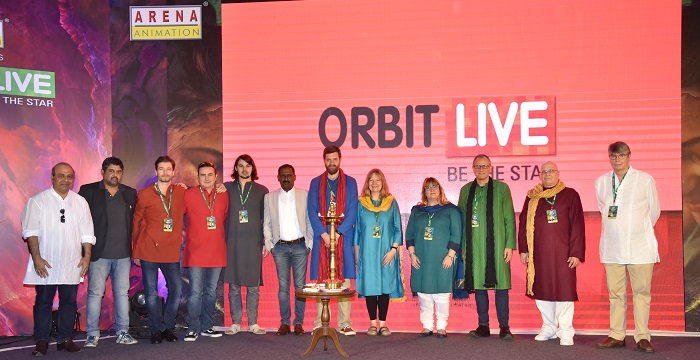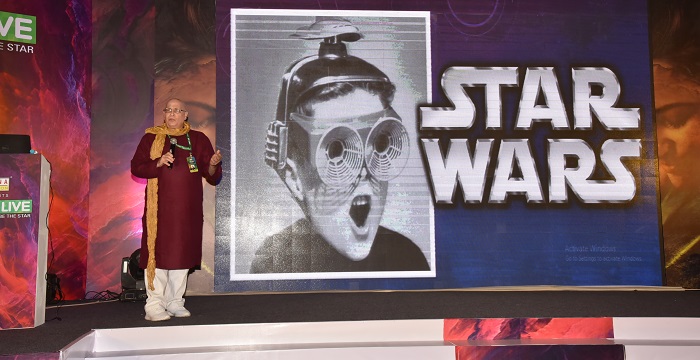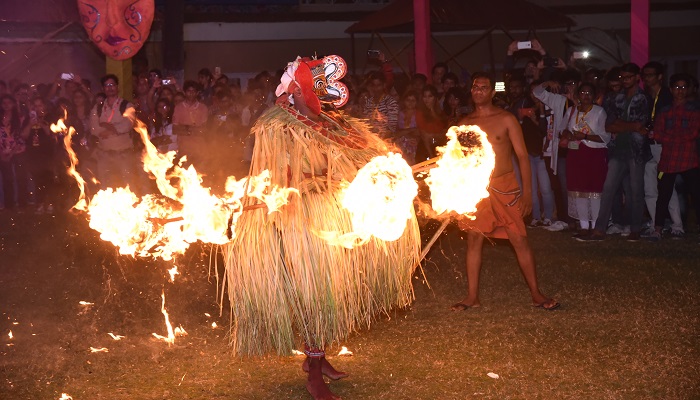Right from keyboard keys bringing the missile man ‘Abdul Kalam’ to life to Rs 2000 note being etched with woollen threads, one can find these art pieces on the the luscious lawn of The Retreat hotel as the the ‘Kala Kars’ try to showcase their talent on the floor. Yes! It’s that time of the year when the hotel is filled up with aspiring students who want to make a place for themselves in the animation, visual effects and graphic designing industry. Organised by Arena Animation, Orbit Live 2017 in its fifth edition observes 253 students taking part in the four day event (2 February to 5 February, 2017) where they get to connect with the paragons of excellence who have been working in AVGC field around the world.
The first day kick-started with Vaibhav More, who calls himself a small-time animator based in Mumbai, mentioning the fact that animation is regarded as a medium where serious things can be portrayed in a comical manner. Having said that he went on to showcase his short animated videos done as a promotion for Yash Raj’s film, ‘Luv Ka The End’ and also the MTV ‘Caps On’ ad (World AIDS Day) wherein a serious message was narrated in a comical way.

With More’s light-noted talk, the festival was officially inaugurated by the dignitaries who shared the stage to light the lamp as the traditional ritual for a positive start. Post the lamp-lighting ceremony, Aptech, MD and CEO, Anil Pant while speaking a few words with the audience said, “If you want to be a CEO, don’t take life seriously. Passing and failing is all part of life. At the end of the day if you enjoy what you are doing, then you can achieve what you want to.”
Now it was the time for the international keynote address by Nik Powell who’s the director of National Film and Television School, UK, on ‘The Future of Media and Entertainment’. A guy with humour, Powell, who was the co-founder of Virgin along with Richard Branson, said that he had no idea of how the future of the digital world would be. He started by explaining what is going around the world in science and technology and the progress made in the fields of Virtual Reality (VR) over the years. He also shared with the students a few lessons that he learnt from Branson, which were: You’ve got to challenge the big ones, keep it casual, don’t take no for an answer everything is negotiable, don’t lead ‘sheep’ herd ‘cats’ and move like a bullet.
Further he mentioned the fact that unlike in the 1900’s where VR couldn’t survive, right now VR is the big thing. Why? Because of the fact that there are many platforms including the three biggest players (Oculus VR, Samsung Gear, Playstation VR), it captures imagination, mobile VR has been legitimised. As for mobile phones, they are going to be the mainstream consumer platform for AR / VR. Here are some of the predictions by him: VR will not be big in storytelling, 360 degree video will be used to enhance storytelling and not replace or reinvent it, content is still going to be the king. He bid adieu by saying, “Future is all about feeling!”

This was followed by a seminar on the ‘Evolution and Mysteries of Star Wars Saga’ by Craig Miller. The president of Wolfmill Entertainment, USA, spoke to the crowd about how they marketed Star Wars to the people before it hit the theatres in 1977. Regarded as the ‘best transmedia campaign’, there were a lot of efforts put it to create Star Wars and reach the place where it is now. Miller gave insights on how the team spent a year building the audience for a genre that had not established itself then in the film industry. They practically had “to persuade people to come and watch science fiction movies in the time when they were least interested”. The various tools to market it were by marketing it at the San Diego Comic Con, used rumours to build the hype, promoted it by creating a hotline number wherein new messages by the characters were released every month, did a lot of commercials for licensing, tied up with Sesame Street and so on.
When the team created Star Wars and marketed it, they only expected it to be successful/break-even and earn profits. How it became a huge franchise with a loyal fan-base till date, is still a surprise to him. “While working on any project, do the best you could do to make it successful. You never know you might be working on one of the most successful projects,” shared Miller.
After the high-tea break, the founder and director of Kizny Visuals, Patryk Kizny introduced the students to a niche field – Timelapse Cinematography. Kizny shared his journey from being an astro photographer to his experiments with wider angle images and then turning completely into “timelapse cinematography” as he likes to call it, as opposed to “timelapse photography”. “It all started with my curiosity and desire to execute better shots,” mentioned Kizny, as he spoke about his interest in timelapse and the challenges he faced with motion control and shooting under-water.
Timelapse is basically shooting film frame by frame using still images. Each frame is played back in shorter time than registered. There’s static, motion control, hyperlapse and the recent flowlapse form of timelapse cinematography.
The young director of Kizny Visuals thinks of himself as an artist rather than an entrepreneur. He mentioned that while making a hyperlapse video, it is utmost important to have precise time measurements and move the tripod carefully. As for his latest experiment with underwater timelapse, the biggest challenge he faced was the changes of pressure underwater. Kizny went on to showcase his most rewarding work, a short-film called ‘The Chapel’, which is a combination of timelapse, motion control and HDR. The short is a remarkable work, portraying the beauty that lied in the ruins of an old church in Poland. Recently, he tried something new by incorporating VFX in his timelapse.
There are debates going on whether timelapse is cinematography or photography, is it a narrative or a non-narrative style of filmmaking, to which he addressed, “If your video fails to express emotion, this is when timelapse becomes a non-narrative filmmaking. For me, timelapse is a narrative form of storytelling, solely in its visual form.” He ended his session with a message: “It is tempting to follow the techniques, however whatever medium you work with, even though it is exciting, it is important to see the bigger picture and what you want to convey through the film.”
First day concluded with fire dance performance from Kerala called “Theyyam”, and a rock music concert. The next three days are filled with master classes and workshops by the industry veterans.
Stay tuned for more updates.


